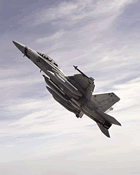
Boeing Successfully Completes Initial Flight Demonstration of EA-18 Airborne Electronic Attack Variant | |
|
This image is available for editorial use by news media on boeingmedia.com Real
Player Quick Time MPEG
|
ST. LOUIS, Nov. 15, 2001 – Boeing today successfully completed an initial flight demonstration of its EA-18 Airborne Electronic Attack (AEA) concept aircraft. The test used an F/A-18F Super Hornet to carry three ALQ-99 jamming pods and two fuel tanks while measuring noise and vibration data and assessing aircraft flying qualities. The EA-18 is one of the platforms under consideration in a Department of Defense analysis of alternatives to replace the EA-6B Prowler electronic warfare aircraft. The U.S. Navy has an operational need to start replacing the Prowler by 2008. "The EA-18 will perform full-spectrum electronic surveillance and electronic attack of enemy threat radars and communications nets," said Paul Summers, director for Boeing's F/A-18 derivative programs. "The EA-18 leverages the U.S. Navy's investment in the F/A-18E/F Super Hornet platform and Northrop Grumman's Improved Capability III radar receiver system, which represents a significantly reduced risk approach over other unproven platforms and systems." A derivative of the two-seat F/A-18F Super Hornet – a platform which is in production today – the EA-18 is a highly flexible design that enables the warfighter to perform a broad range of tactical missions, operating from either the deck of an aircraft carrier or land-based fields. The EA-18 is 99 percent common with the Super Hornet and would be expected to significantly reduce support and training costs for the U.S. Navy. The EA-18 is the result of an engineering design, development and test effort that began in late 1993. This effort has included avionics and aircraft conceptual design, engineering analysis, high- and low-speed wind tunnel testing, electromagnetic interference/compatibility laboratory testing, antenna range testing and extensive crew-vehicle interface development. The combination of a validated design, proven platform and proven electronics positions the EA-18 program to begin a system development and demonstration phase as early as 2003. The Department of Defense plans to announce the results of the analysis of alternatives for the AEA mission next month.
### 01-142
Contact: Patricia
Frost |
